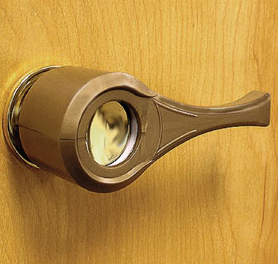|
Door Handles
Modify your traditional doorknobs for pain-free, easy accessibility
Opening a door is a simple task for most people, but it can be very painful - and sometimes impossible - for young children, older people, and those with arthritis. The good news is - it is quick and easy to modify your door handles or attach a hand aid to the existing handles. With simple adaptations, door operation becomes much easier.
Certain doors are intended to be difficult for young children to operate. You, of course, want to make it impossible for kids to get into cabinets and rooms that store dangerous materials. But let's talk about doors and cabinets that should be managed effortlessly.
Levered door handles are the easiest to control. While standard doorknobs need to be gripped and twisted, levers can be pushed with a fist, wrist, forearm, or elbow. Even with painful joints, these levers can be easily used.
If a doorknob cannot be replaced, purchase an adapter that fits right ove r the knob. These ergonomically designed extenders turn a standard round doorknob into a push lever. r the knob. These ergonomically designed extenders turn a standard round doorknob into a push lever.
Cabinet drawer handles and cabinet door handles should also be replaced. U- and D-shaped handles are the easiest to grasp, even with weak hands or painful fingers.
Bathroom and bedroom doors need locks. Make sure you have ones that are easy to lock and open. Choose a door handle with a push button lock that unlocks automatically when the interior lever is pushed open.
While you're modifying the door handles and locks, don't forget the keys!  Standard locks on exterior doors require tiny keys, which are extremely difficult to operate for little hands, or when arthritis is flaring. Look for inexpensive key adapters. They fit right over keys to increase leverage with minimal stress on the fingers. One type of key adapter simply enlarges the end of the key for easier gripping. Another attaches a double opening to slip two fingers in, improving the grip. Standard locks on exterior doors require tiny keys, which are extremely difficult to operate for little hands, or when arthritis is flaring. Look for inexpensive key adapters. They fit right over keys to increase leverage with minimal stress on the fingers. One type of key adapter simply enlarges the end of the key for easier gripping. Another attaches a double opening to slip two fingers in, improving the grip.
Back to top
|